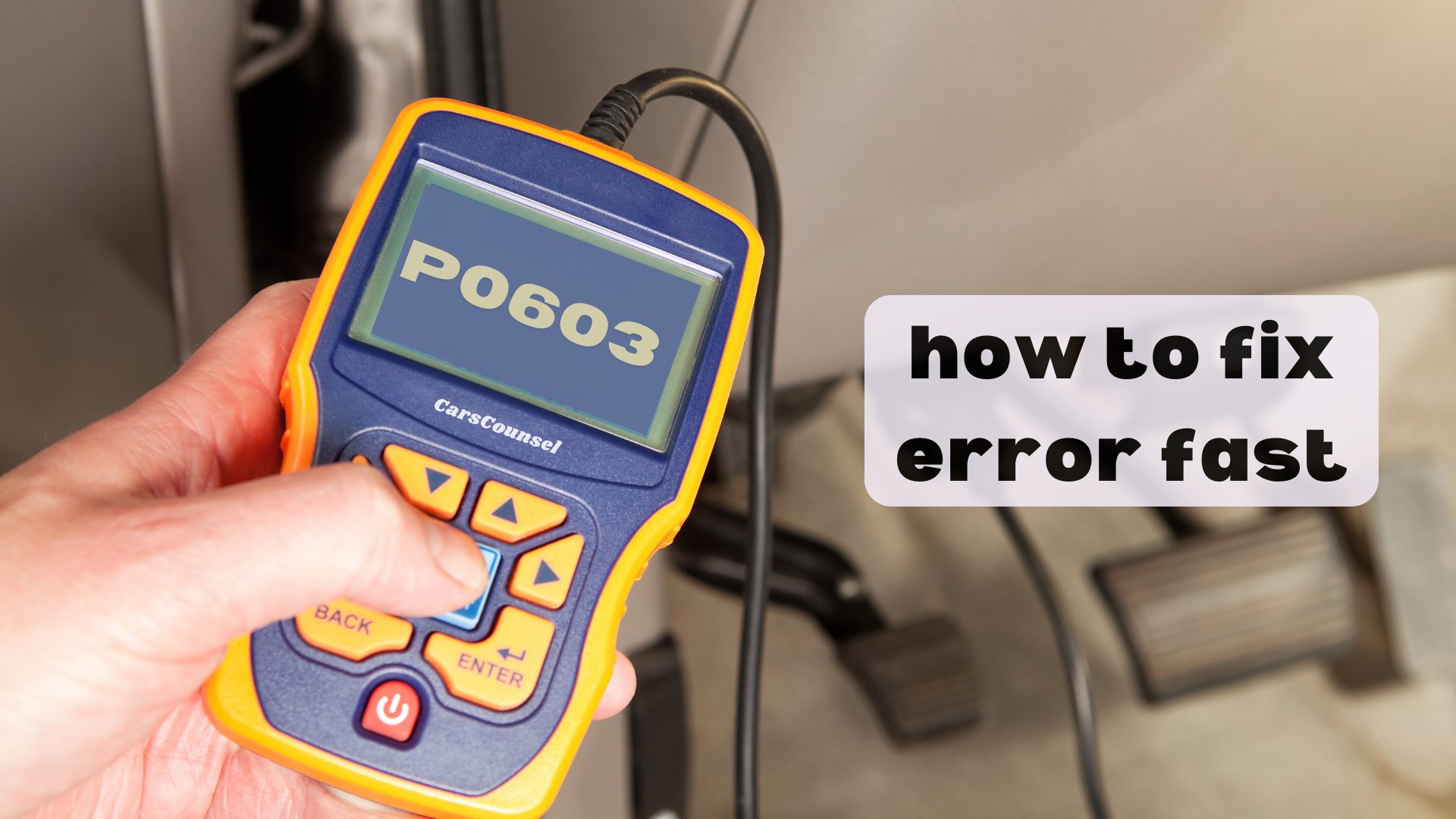Seeing the P0603 code can be a bit scary, but don’t worry, there are simple steps to fix it.
First, check the Engine Control Module (ECM) and its wiring for any signs of damage or rust.
Next, use an OBD-II scanner to read the error codes and see how the ECM is performing.
Make sure your battery is in good condition and all connections are tight.
If the problem doesn’t go away, you might need to update the ECM software or reset it.
Want to know more about what to do next? Let’s dive into the causes and solutions.

Quick Navigation
Key Takeaways
- Look for and fix any damaged or rusty wires and connectors near the engine control module (ECM).
- Check the battery voltage, clean the terminals, and make sure the connections are tight.
- Use an OBD-II scanner to read and clear any trouble codes, including P0603.
- Check if there are any software updates or recalls for the ECM from the manufacturer.
What Is P0603 Code
The P0603 code is a part of OBD2 Codes and it means there’s a problem inside the Engine Control Module (ECM), which is like the car’s computer. This issue could be with the ECM’s memory or its processor.
When this code shows up, it can affect important systems like the engine, transmission, and emissions. This often leads to poor engine performance, lower fuel efficiency, and sometimes the car won’t even start.
To find out if this code is present, you’ll need to use an OBD-II scanner to check the ECM. This involves reading the code, looking at the wiring and connectors, and testing the battery and the ECM’s memory.
Proper diagnostics are crucial to find the exact problem and fix it correctly.
Causes Behind P0603
Understanding why the P0603 code appears is essential for fixing issues with the ECM (Engine Control Module). Common reasons include a faulty ECM, wiring problems, or issues with the battery or charging system. Damaged or corroded wires can disrupt communication with the ECM, and bad electrical connections can also set off this code. Environmental factors and past repairs might also cause ECM failures, sometimes making ECM replacement necessary. Here’s a simple summary:
| Cause | Description | Action Needed |
|---|---|---|
| Faulty ECM/PCM | Problems with internal memory or processor | Look into ECM replacement |
| Wiring Issues | Damaged or corroded wiring | Check and fix the wiring |
| Battery/Charging System | Issues with the battery or alternator | Repair or replace parts |
Recognizing Symptoms
When you see a P0603 code, it means there might be an issue with your car’s computer.
Here are some common signs to look out for:
- Rough idling or stalling: Your engine may run unevenly or cut out.
- Reduced engine performance: You might notice your car has less power and slower acceleration.
- Inconsistent speedometer readings: Your speedometer might show the wrong speed or jump around.
Spotting these signs early can help you fix the problem before it gets worse and costs more to repair.
Keep an eye out to make sure your car stays in good shape.
Initial Visual Inspection
Before getting into complicated diagnostics, start by looking over the wiring and connectors for any signs of damage or rust.
Find the ECM, which is usually in the engine bay or under the dashboard, using wiring diagrams to help you.
Make sure all the wires and connectors going to the ECM are in good shape and don’t have any visible fraying or rust.
Check for wear and tear, like cracked insulation or loose connections, that could mess with the ECM’s signals.
Also, look at the harnesses to see if any wires are pinched or bent.
Doing this quick visual check can often uncover simple problems that can be fixed easily, saving you from spending more time on complex diagnostics later on.
Using an OBD-II Scanner
After you’ve checked the car visually, plug in an OBD-II scanner to the vehicle’s diagnostic port to read the trouble code and see if P0603 is present. The OBD-II scanner is a vital tool for quickly diagnosing problems.
Here’s how to do it:
- Turn on the scanner: Make sure the scanner is properly connected and powered up.
- Choose OBD-II functions: Use the menu to select the right diagnostic options.
- Read and note down codes: Find and write down the specific trouble codes, including P0603.
Using these OBD-II functions will give you helpful information, making it easier to figure out and fix the P0603 code.
Testing Battery Health
Checking your car’s battery health is important to make sure the engine control module (ECM) gets steady power and works right.
Start by using a multimeter to test the battery. When the engine is off, a fully charged battery should show around 12.6 volts or more. With the engine running, it should show between 13.7 and 14.7 volts, which means the charging system is working well. If your readings are outside these numbers, you might need to replace the battery or check the alternator.
Also, look at the battery terminals to see if they’re corroded and make sure they’re tightly connected.
Simple maintenance tips include cleaning the terminals, checking the fluid levels in batteries that aren’t sealed, and making sure the battery is secure in its tray.
These steps help keep the battery in good shape, which is important for the ECM to work properly and to avoid getting the P0603 error code.
Checking ECM Memory
Checking your ECM memory to make sure it’s working right can help you avoid the P0603 error code. Keeping your battery in good shape is also important for your ECM to work well.
Here’s how you can check your ECM memory:
- Run a checksum test: This makes sure the memory data is correct and not corrupted.
- Look for error codes: Use an OBD-II scanner to see if there are any issues with the memory.
- Check wiring and connections: Make sure all ECM connectors are tight and not corroded.
Software Updates and Recalls
When dealing with the P0603 code, it’s important to check for any software updates or recalls, as manufacturers often release updates to fix known issues with the ECM.
These updates can improve compatibility and resolve various bugs.
Contact your vehicle’s manufacturer or visit their website to see if your vehicle needs any module reprogramming.
Make sure your ECM software is up to date to avoid recurring problems.
If there’s a recall, the manufacturer usually covers the costs.
Ensuring your vehicle’s software meets the latest standards can prevent the P0603 code from coming back.
Proper module reprogramming can save time, money, and help your vehicle run smoothly.
Resetting the ECM
Resetting the engine control module (ECM) by disconnecting the battery is a common way to clear temporary problems that might cause the P0603 code. This method can be a good first step in figuring out what’s wrong.
Here’s how you do it:
- Turn off the car: Make sure the car is completely off to avoid any electrical issues.
- Disconnect the negative battery cable: Use a wrench to loosen the bolt and remove the cable.
- Wait at least 15 minutes: This gives the ECM enough time to fully reset.
This can help reset the ECM and possibly get rid of the P0603 code. If the problem is still there, you might need to try other troubleshooting steps.
Replacing Faulty Components
Replacing bad parts involves finding and swapping out damaged wires, connectors, or the ECM to fix the P0603 code and get your vehicle running smoothly again.
Start by carefully checking all parts. Look at the wires for any damage, rust, or wear and tear. Change any damaged wires and make sure all connections are tight and clean.
Next, make sure the connectors are properly plugged in and not broken. If everything looks good but the code is still there, the ECM might be the problem. In that case, you’ll need to replace the ECM.
Always check the system after each fix to make sure the P0603 code is gone and your vehicle is running well.
More OBD-II Codes
Frequently Asked Questions
Can Driving With a P0603 Code Damage My Vehicle?
Driving with a P0603 code can hurt your car by affecting how the engine runs. Use diagnostic tools to find the problem quickly. Ignoring the code could lead to bigger issues and expensive repairs later on.
How Much Does It Cost to Fix a P0603 Code?
Fixing the P0603 code can cost anywhere from $150 to over $1,500. The price depends on what’s causing the issue, like a bad ECM or wiring problems, and how complicated the repair is. Symptoms like rough idling and stalling can be annoying, but the main factors that decide the cost are the specific problems with the ECM or wiring.
Is It Safe to Drive With the Check Engine Light on Due to P0603?
It’s not safe to drive if the check engine light is on because of a P0603 error. You should use diagnostic tools to figure out the problem. Driving with this issue can cause your car to run poorly, get more damaged, or even be unsafe.
Can a P0603 Code Affect Fuel Economy?
Yes, a P0603 code can hurt your fuel economy. It can cause engine problems like rough idling or stalling, which makes your car use more gas and lowers its overall efficiency. Fix it as soon as you can.
What Professional Services Can Diagnose and Fix a P0603 Code?
You can count on professional mechanics to diagnose and fix a P0603 code. They will use OBD-II scanners to check for issues, inspect the battery and wiring, and might reprogram or replace the ECM/PCM if needed.
Conclusion
To fix the P0603 code, follow these steps.
First, check the Engine Control Module (ECM) and its wiring. Use an OBD-II scanner to diagnose the issue and look at live data.
Make sure your battery is in good condition and all connections are secure.
If the problem continues, consider updating the software or replacing any faulty parts.
Remember, fixing ECM problems early can prevent bigger issues later on.

